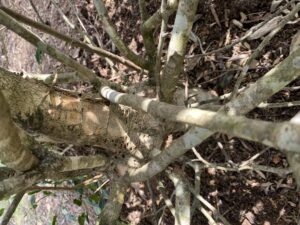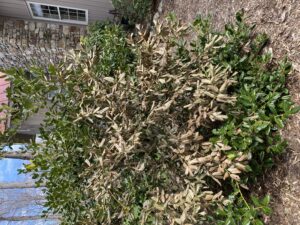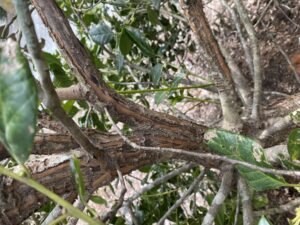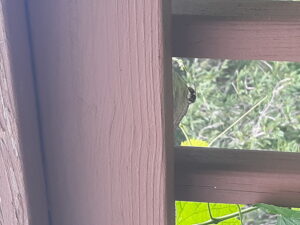Pest Alert – Hornet Damage on Shrubs
go.ncsu.edu/readext?853350
en Español / em Português
El inglés es el idioma de control de esta página. En la medida en que haya algún conflicto entre la traducción al inglés y la traducción, el inglés prevalece.
Al hacer clic en el enlace de traducción se activa un servicio de traducción gratuito para convertir la página al español. Al igual que con cualquier traducción por Internet, la conversión no es sensible al contexto y puede que no traduzca el texto en su significado original. NC State Extension no garantiza la exactitud del texto traducido. Por favor, tenga en cuenta que algunas aplicaciones y/o servicios pueden no funcionar como se espera cuando se traducen.
Português
Inglês é o idioma de controle desta página. Na medida que haja algum conflito entre o texto original em Inglês e a tradução, o Inglês prevalece.
Ao clicar no link de tradução, um serviço gratuito de tradução será ativado para converter a página para o Português. Como em qualquer tradução pela internet, a conversão não é sensivel ao contexto e pode não ocorrer a tradução para o significado orginal. O serviço de Extensão da Carolina do Norte (NC State Extension) não garante a exatidão do texto traduzido. Por favor, observe que algumas funções ou serviços podem não funcionar como esperado após a tradução.
English
English is the controlling language of this page. To the extent there is any conflict between the English text and the translation, English controls.
Clicking on the translation link activates a free translation service to convert the page to Spanish. As with any Internet translation, the conversion is not context-sensitive and may not translate the text to its original meaning. NC State Extension does not guarantee the accuracy of the translated text. Please note that some applications and/or services may not function as expected when translated.
Collapse ▲Do you have a holly, magnolia or other plant that has dead branches? When you look at the tree closely do you see missing bark? It is likely that you have had hornets stripping the bark off of your tree to make nests in the past or maybe currently.
European hornets are not the Japanese ‘murder hornets’ you might have heard of. They are an invasive hornet brought to America in the holds of colonial ships hundreds of years ago. The hornet is generally not given to harming people although when agitated by anyone attacking their nest they can be highly aggressive. They can sting over and over and can be relentless in pursuing anyone who messes with their nest.

European hornets strip bark from hollies and other trees to make their nest sometimes killing limbs or entire plants.
These hornets build big basketball sized paper nests. In these gray paper mache hives a single queen raises daughters who leave the nest to hunt other insects and to gather bark. They strip the bark off of trees and regurgitate it as a paste that they form into the nest.

European hornets strip bark from hollies and other trees to make their nest sometimes killing limbs or entire plants.
Trees where hornets harvest bark can be visited by succeeding generations of hornets over years. Eventually the hornets girdle stems and kill branches. The areas where bark were harvested in years past form checkered patterns as the tree tries to seal these wounds.
There are no recommended pesticide treatments for shrubs to deter hornets. A bifenthrin bark spray applied to the bark might kills hornets that harvest the treated bark but this is conjecture on my part.







